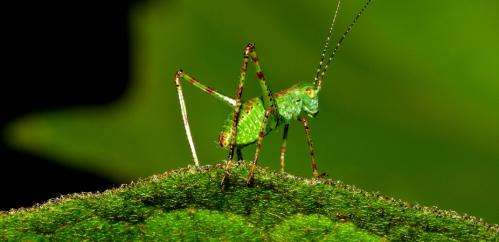This parasite is the stuff a cricket's nightmares are made of

The hairworm is a long, thread-like parasite that sits bundled up inside the body of its host. It grows so large that it takes up most of the room inside the host's body, waiting for the right moment to come bursting out. But that is not the scariest thing about the parasite, because it can also survive a deep freeze (at -70°C) and go on to infect its favourite hosts. Fortunately for us, those hosts are some insects and crustaceans.
The adult hairworm (in the phylum Nematomorpha) is aquatic but in many species the worm develops inside land-loving insects. To ensure it does not dry up when it escapes from the innards of its host, it uses its first trick to manipulate the host. When the time has come for it to make an exit, the hairworm is able to tamper with the brain of its host (usually a cricket) and persuade it to seek out water, where the adult worm can escape and reproduce.
But the hairworm has a complex life cycle and the cricket is not the only host that it infects throughout its life. Before it gets into a cricket, this parasite starts out as an egg that hatches into a free-swimming larva, which then needs to infect an aquatic invertebrate, such as a snail or mosquito larva, to reach its next stage of development as a cyst. It then needs to be eaten by its final host - the cricket - where it matures into a long, thin worm, many times longer than the length of its host (see video).
This process of getting into each of those hosts and waiting to encounter the next one may end up being dragged out over the course of an entire year. For hairworms that live in temperate regions of the world, the parasite is faced with a dilemma - there is a good chance that before it is able to end up in a cricket and develop into an adult worm, winter will arrive and everything will start freezing over.
But the hairworm Paragordius varius is not at all bothered by snow, ice and freezing conditions - it simply shrugs it all off and waits it out. In fact, a recent study showed that it can tolerate being frozen at -30°C or even -70°C for weeks. When it thaws out, it is still fully capable of infecting the next host.
The hairworm is not the only parasite which can survive freezing conditions - so can some roundworms and fluke larvae that infect the wood frog Rana sylvatica. During winter the wood frog simply turns into an ice block and its organs are protected from freeze injuries by chemicals like glucose and urea - perhaps the frog's parasites have similar ways of dealing with the cold.
Another species of roundworm, Trichinella nativa, which infects the muscles of arctic mammals such as arctic foxes and polar bears can also survive being frozen at -18°C for up to four years and still remain viable. While T. nativa infects mammals that maintain a consistently warm body temperature, it needs to be eaten by a predator or (more likely) a scavenger to complete its life cycle, so it has to stay alive while trapped in a frozen cadaver until liberated by a potential host.
Thankfully such feats of cold tolerance are rare - deep freezing at temperature of -35°C or colder for extended period is actually recommended as an effective way of getting rid of Anisakis simplex, a nematode parasite also known as sealworm, which is sometimes found in fish. People become infected by this worm when consuming raw or under-cooked fish and while it would prefer infecting marine mammals, it can still cause a really nasty stomach ache or even an anaphylactic reaction.
While the hairworm's tolerance for deep freezing allows it to complete its life cycle regardless of seasonal changes, this is also a boon for scientists who study them. Usually, doing lab-based experiments on parasites like the hairworms, which infect different species of hosts throughout its life cycle, is a logistical hardship. You have to maintain colonies of many different critters (potential hosts to "sacrifice" to the parasites) to keep the life cycle going. If you want to start up a lab colony by collecting a starting population from the field, just when various stages of the parasite might be available for collection out in the field, the suitable hosts might be scarce or absent. But with P. varius, all the scientists have to do is pop them into deep freeze and put the parasite's life on hold until suitable hosts (or funding) become available to continue working on them.
So even though P. varius would normally allow itself to freeze for the sake of its survival, they can also be made to freeze in the name of science.
Source: The Conversation
This story is published courtesy of The Conversation (under Creative Commons-Attribution/No derivatives).
![]()


















